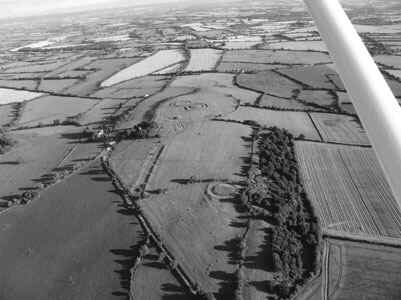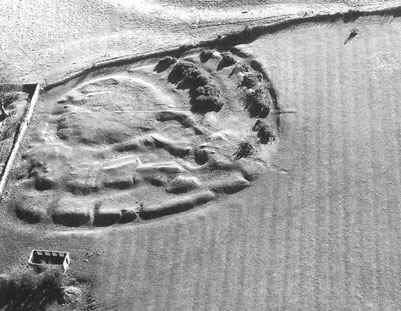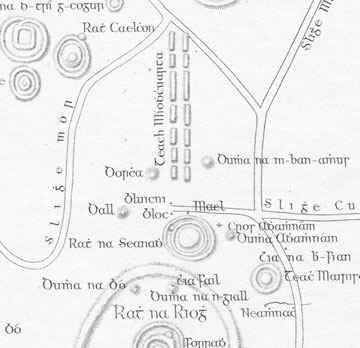
| THE HANDSTAND | LATE AUTUMN2008 |
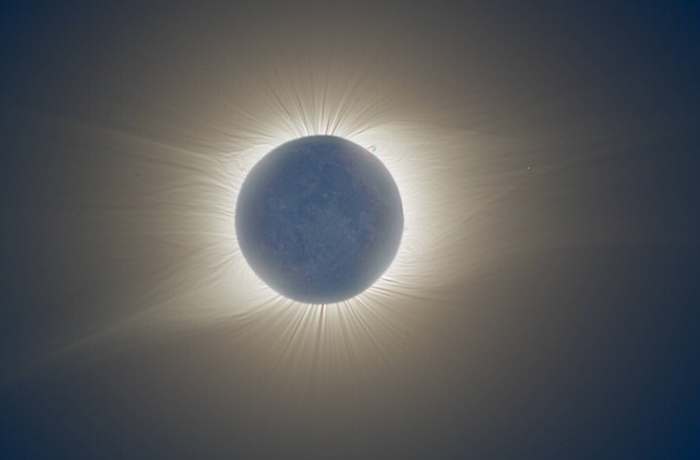
Citizens Petitions
Debate Speech Monday 22nd
September 2008 Kathy Sinnott Mr
President, I consider the Committee on Petitions
the most important in this House. It is a forum
in which the citizens tell us how the many laws
that we deal with in other committees affect them
or do not affect them. Without this feedback we
are doomed to work in a vacuum. But, in terms of
its work of standing up for The
people of |
* * * * * * * * * * * * * * * * *
www.savetara.com;www.tarapixie.net;www.taratemple.net;
www.sacredIreland.org;www.tarasolidarityvigil.net
; http://homepage.eircom.net/~guerin/videos.html
www.schnews.org.uk;
http://www.livevideo.com/video/1078F7A1974C4180AC7C538E44A46D27/
www.tara-tara-tara.aspx
; www.savetaravalley.com
; www.taranetwork.org
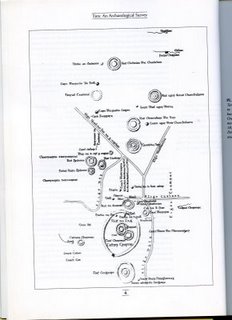
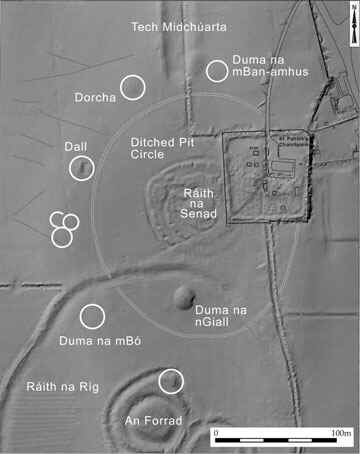
GABHRA VALLEY, CO. MEATH
A heavy cloth of the shield for us
Turbulent wing beat for us
To pass in the rain bare-headed
Soft pulse of the heart in hand
Heavy bed-sheets of rain for us
Spirals of light for us
Calm palace of the dawn
For the pearl of the sun
Passing a rare blade through a pleated fret
A shaft in the hanging storm curtain
Rising out of the seas’ bed for us
Three times to infinity
In solitude a reprimand the rain’s
Sentinel closes the road for us
Hidden the close fragrance of the shield
Turbulent the strong wing for us
Spiral in the light a blade of redress
For our grief on the
road.
jocelyn braddell©
Social
Control
The 4th to 6th Centuries AD
heralded a new type of social control.
Prior to these times a military censure of social control was spread all over Europe by the Romans and then by the Russ or Mongol tribes from Northern China
In the Mediterranean the Jews and their cult off-shoot Christianity began to strengthen.
The Roman Senators did not actually censure Christianity when it first made its appearance as all religions were tolerated as private affairs; but they were irritated considerably by Cristianity's censure of all other cults and religions, maintaining that they were right in truth, in faith and in belief of the one God.
This religious mono-mania had already occurred in Egypt - The tribal sacrifice of a king having been eradicated by sleight of hand, God, it was established had designated the Pharaos of the Nile Delta.
It must have taken everybody by surprise as the Rome Senate weakened, to find that their private terrors and fears were to become punishments, public remonstrance in prayer and abnegation, comprising a sudden and utter absence of any joyful confidence in life as a freely obtained blessing of attention as in the past, attention to the attributes of nature, of the human mind, and of the vigour of the body for all its potential activities.
Thought about this by any individual became circumscribed by this new cult, and the Crucifixtion of Christ. The main treatise within this religion, of the punishment by torture and death of the individual thinker, began to overule society as it obtained power and political recognition. A tool for the powerful! As had, infact, symbolically already begun in Greece when Socrates was poisoned. This social horror of a tortuous justice was hung on the Cross, where the individual, Jesus Christ, had pledged that from the Omnipotence of God, and as God's Son, he held all the sins of the world in his fists closed round those brutal iron nails.
Mankind already knew that torture was the perogative of many damaged and insane minds - As early as 180 AD competition and rivalry within the Roman Empire had acquainted them with cruelty, that is to torture life, not the extinction of life with murder. Man knew well of its its association with a deceased imagination, its practice by power, and the bully, and the strange shadow such practices threw over a population seemingly unable to suppress it.
Christianity that religion of the humble, the
submission to a fate decreed, claimed to be a social
control by taming the mind, suppressing its violent
passions and creative of a new social contract for a
numerous population. By the fourth Century AD
Christianity had spread far and wide. A surprising
adjunct of that spread was that one small island on the
edge of Europe supplied nearly all the great figures,
teachers and organisers of this new religion. Why was it
that Irishmen and women in the 5th and 6thCenturies
founded many of the great monastries of Europe? Could it
have been that they had a mental outlook from an Irish
civilisation that more readily understood the project of
political control than the powerful Kings, Barons and
tribal leaders within Europe? It was certainly not a
Celtic attribute - it was purely an Irish attribute.
The faith of
Christ who suffered in the flesh
has brought all strength to nought;
because of the sorrow of the people of God in its house
He gave not protection to Temair.
What lay behind this extraordinary development of a virtually closed society in Ireland that had not been invaded and occupied for nearly two thousand years?
By the 6th Century the Mediterranean and southern European boundaries had stabilised in recognisable areas of rule. Algeria, Egypt and Persia during the 600's AD were all in turmoil. It was the advent of Mohammed and the structure of his religious acknowledgement of the solitary God of the Jews and the Christians that began the structure of Social Control in Arabia and all her occupied kingdoms.
The Jews had their Talmud and texts, the Christians had their Bible and the Creed. Mohammed instructing his followers within the caliphates created the Koran .
The Irish had their long held mnemonics of the
Brehon Laws said to have been created by Fodlah 1,400
years BC. They had also created a music cannon of
extraordinary beauty. They used and adapted instruments
they had seen in the Arab world when trading with them,
and beyond that chess and other board games entertained
them, horse racing and even our famous ball-game of
Hurley that is today found in North Africa among the
Bedouin and Arabs. Also they had an integral military,
the Fianna, who fought to take control when any tribal
king of the four kingdoms of Ireland could not restrain
his greed or ambitious mania. They could be regarded
perhaps today as an integral police force! (The Gabhra Valley is the putative site of
the last battle of the Fianna in 284 A.D. and they were
said to buried where they fell along with Cairpre
Lifechair king of Tara son of Cormac mac Airt.)
But of even greater
interest is the manner in which this kingdom lived for 1,400
years in turbulence but in peace, in beauty but in
hardship, in friendship but subject to betrayal. The
Irish developed the organisation of their affairs by
dividing the terrain into five areas. The foremost area
for our interest here is the area where all the tribes
assembled to regulated their affairs, their taxes, their
marriages and the election of Kings.
When
Cormac was among the famous
bright shone the fame of his career;
no keep like Temair could be found;
she was the secret place of the road of life.
This area which is now to all appearances a bleak uncared for hill beset with sheep in long grass they are scarce grazing, with some ruined circles and mounds, only one of them having an entrance to the east with a short passage therein. When that last mentioned mound was archaeologically investigated in the early 1900s some urns with cremated human ashes were found in the walls of the mound itself. Is this all that we have left of this historic and important area after the passage of centuries? Other burial sites of prominent construction and mystery have been found elsewhere, but Tara has been and is now neglected as if under some curse. Also, the history of this Hill does not comprise only the Hill itself but to a large measure the long valley to the east of it, a shallow valley with Skyrne Hill and Rath Lugh bordering its easter stretch and surrounding forts to the south west and north.
However let you not suppose that the Irish themselves are uninterested or unaware of their especial history at the beginning of Time, as it were, of the development of Europe's civilisation, varied populations, and integral political structure.
This interest has reached a critical stage here
in Ireland during the last few years, and it is fair to
say that a young population has been horrified to realise
that a modern four-lane road construction has been thrust
into this valley and passed over amazing discoveries of
cemetries with souterrains of pagan construction, a
circular assembly area the size of three football fields,
of an unknown Bronze Age village settlement, and this
road has passed over many sites previously mapped and two
major new discoveries,archaeological sites of interest
between huge spaghetti junctions planned for either end
of this M3 road diversion. This road has been built
because speculators, who are going to take a toll there
for every vehicle of the 22,000 expected to pass there
every 24 hours, are also planning to use the area as a
passive introduction to Irish history, a site of
spiritual significane to the Roman Church, but also of
spiritual significance to the Irish people as the symbol
of their exceptional qualification in history as
political creators, peacemakers, and a population that
succumbed only in the modern world to the rule of
religion and Norman and Anglo-Saxon planters and are now
expected to succumb to the speculators and betrayal of
their own government.
jocelyn braddell Sept.2008
From Vol33 The Dindshenchas The House of
Temair, round which is the rath, King and
Chief of the Poets, Leech and
spencer, stout smith, Engraver,
famed architect, Jester, chess-player,
sprawling buffoon, The shins
were the share of the noble musician, A charge on
the prince of Meath, The backs,
the chines in every dwelling |
| Hill of Tara info from www.tarataratara.net/ Conor Newman is a lecturer in
archaeology at the Department of Archaeology, N.U.I.
Galway. "Before my appointment to Galway I
was director of the Discovery Programme's Tara
Survey with which, I have no doubt, you are all
familiar. The Discovery Programme is still
actively involved in the study of Tara and a
significant component of that work is now carried
out in collaboration with the Department at N.U.I.
Galway. The Discovery Programme's work on Tara
began in 1992, but my engagement with the
archaeology of County Meath began some ten years
earlier in 1982 and has continued, uninterrupted,
since then. I am presently director of a multi-disciplinary
research project, funded by the Irish Research
Council for the Humanities and Social Sciences,
on the Blackwater Valley, which is also affected
by the proposed motorway.......... The Hill of
Tara is one of the most important and famous
archaeological complexes in the world. You may
have been expecting me to say '.. most important
in Ireland' or maybe '... most important in
Europe' but the fact is Tara commands a place on
the world stage. This is not hyperbole, it is a
statement of fact. As such, it is a major
cultural and heritage resource, one that is only
really beginning to be developed and exploited as
such............................It is not
surprising, therefore, that from the very outset
this route was identified as the least desirable
from the archaeological point of view: the
attrition rate on the archaeological heritage
will be far greater here than for any other of
the proposed routes. That is not just my
conclusion, it is the conclusion arrived at by
the archaeological consultants involved in the
route selection process. What is surprising,
therefore, is that, in spite of this, the
National Roads Authority has selected this as the
preferred route..........I am in a privileged
position to be able to talk about the geophysics.
Why? Because I am one of the very few people (possibly
the only person) on this side of the house to
have seen the geophysical images. They were not
included in the Environmental Impact Statement.
Instead, what we got were interpretive drawings
that we had to take at face value. This is
completely abnormal practice. I have never
encountered a situation before where the
geophysical images were not provided alongside
interpretive drawings. It is an industry standard. As religious and political ceremonies, and the places where they occur, evolve, they generally do so with specific reference to the historical past of that locus and of the institutions associated with it: as Waddell (2005, 22) observes, origin myths are both divorced from and joined to the contemporary world with ritual serving to connect the mythical past with the present. Historical affirmation is thus achieved through regular repetition of tried and tested ceremonial formulae. The prefix to Cúán úa Lothcháin's poem Temair toga na tulach confirms this in the case of Tara: Suidiugad Tigi Midchuarta. Ní cac ri las ta indiu amail bae la Conn Ceth-catach, occus tech n-Airt, occus Cormaic, occur Cairpri Liphecair, occus tech Cathair Máir, occus tech gac rig ro fallna I Temraig co Niall Naicclech, arrulaed fo tri ro giall h-Eriu do fo tri. The situation of Tech Midchuarta. "Each king who has it at this day does what was done in the time of Conn of the Hundred Battles, and [when it was] the house of Art, and of Cormac, and of Cairbre Liffeachair, and the house of Cathair Mor, and the house of every king who ruled in Temur to Niall of the Nine Hostages, who made a visitation thrice, and to whom Ireland was rendered hostages thrice.\par (From the Yellow Book of Lecan (TCD MS 1318) col. 245 translated by O'Donovan and quoted in Petrie 1839,
Figure 2 Ráith na Senad (Rath
of the Synods) looking south. Encroached on by
the churchyard wall and a townland boundary,
damaged by the British Israelites during a search
for the Ark of the Covenant around 1900, and
excavated by S.P. Ó'Ríordáin in the early 1950s
(unpublished), Ráith na Senad is a complex,
multi-phase earthwork. The remains of the
incorporated barrow can be seen in the north-west
quadrant. (Photo: Leo Swan, Spring 1973) Detail from George Petrie's reconciled and annotated plan of the monuments on the summit of the Hill of Tara (Petrie 1839, pl. 7) showing the spatial relationship between Tech Midchúarta and the barrows known as Duma na mBan-Amhus and Dorcha. Tara was a temenos, a sanctuary,
a place apart, indeed a place cut off from this
world: it was the domain of the gods. The
builders of Tech Midchúarta had, therefore, not
just to succeed, as they clearly did, in finding
an architectural form that blended with what was
already present physically at Tara, they had also
to meet the far more esoteric requirement of
creating a space that converged with the
religiosity and iconography of Tara as a
sanctuary, and with the institution of sacral
kingship itself....................At the core of
the monuments on the Hill of Tara is the
sanctuary of Ráith na Ríg. Through an inversion
of the normal, its external bank and internal
fosse may be an architectural motif intended to
symbolize the paranormal, the reflexive, binary
dynamic between gods and humans. This is the
Otherworld into which the sacral king must pass,
and it is the nexus from which he must eventually
emerge as the conduit and intermediary between
the human world and the world of the gods. The
king's reign is the very life-blood of his people,
a sentiment that may be reflected in the
following stanza of the Metrical Dindshenchas
eulogizing Cormac mac Airt: Newman in his detailed archaeological survey of the Hill of Tara also examined a broader landscape of about 100km 2 around the hill (study zone 2).Using aerial photographs, maps and other sources, he identified 23 new archaeological sites in this broader landscape with a minimum of 18 of these considered as potentially prehistoric monuments, most probably ritual sites with some possible settlement sites. The remaining 5 were circular enclosures, identified as cropmarks, of unknown date.8 The Dunshaughlin-Navan section of the M3 overlaps with this study zone for approximately 11km of its length, from Clowanstown townland north of Dunshaughlin to Ardsallagh townland south of Navan. The M3 archaeological investigations (using aerial photography, maps, archival sources, but also geophysical surveys and test trenching) have now identified 25 new archaeological sites within the relatively narrow band encompassed by the road landtake (an area that covers 1.6% of Newman's broader study area). Approximately 17 of these sites are currently identified as prehistoric sites. The majority of monuments on the Hill of Tara itself are also thought to date to the prehistoric period and to have been burial or ritual monuments. While ritual monuments occur in the surrounding area Newman suggested that the hilltop was especially set aside as a ritual area, and that contemporary settlement sites were located in the surrounding hinterland. Neolithic Bronze Age *********************** |
It is
said that a curse was put on Tara in 200AD, placed by a
roman Catholic "saint" on the reigning King.
Here is the story
:
Tara was deserted in the time of King Dermot, the son of Fergus Kervall, on account of St. Ruadan's curse.
************************
In every recorded
instance the power of the clergy had been omnipotent in
politics for above a century. St. Patrick had expurgated
the old constitution; St. Ruadan's curse drove the kings
from Tara; St. Columbkill had established the
independence of Alba, and preserved the Bardic Order; St.
Moling had abolished the Leinster tribute. If their power
was irresistible in the sixth and especially in the
seventh centuries, we must do these celebrated Abbots and
Bishops the justice to remember that it was always
exercised against the oppression of the weak by the
strong, to mitigate the horrors of war, to uphold the
right of sanctuary (the Habeus Corpus of that rude
age), and for the maintenance and spread of sound
Christian principles.......
THE five years of the sixth century, which remained after the death of Hugh II., were filled by Hugh III., son of Dermid, the semi-Pagan. Hugh IV. succeeded (A.D. 599) and reigned for several years; two other kings, of small account, reigned seven years; Donald II. (A.D. 624) reigned sixteen years; Connall and Kellach, brothers, (A.D. 640) reigned jointly sixteen years; they were succeeded (A.D. 656) by Dermid and Blathmac, brothers, who reigned jointly seven years; Shanasagh, son of the former, reigned six years; Kenfala, four; Finnacta, "the hospitable," twenty years, and Loingsech (A.D. 693) eight years.
Throughout this century the power of the Church was constantly on the increase, and is visible in many important changes. The last armed struggle of Druidism, and the only invasion of Ireland by the Anglo-Saxons, are also events of the civil history of the seventh century.
It is pretty clear also that the last rally of Druidism against Christianity took place on the plain of Moira. It was the year 637, and preparations had long gone on on both sides for a final trial of strength. Congal had recruited numerous bands of Saxons, Britons, Picts and Argyle Scots, who poured into the Larbours of Down for months, and were marshalled on the banks of the Lagan, to sustain his cause. The Poets of succeeding ages have dwelt much in detail on the occurrences of this memorable day. It was what might strictly be called a pitched battle, time and place being fixed by mutual agreement. King Donald was accompanied by his Bard, who described to him, as they came in sight, the several standards of Congal's host, and who served under them. Conspicuous above all, the ancient banner of the Red Branch Knights-"a yellow lion wrought on green satin"--floated over Congal's host. On the other side the monarch commanded in person, accompanied by his kinsmen, the sons of Hugh III. The red hand of Tirowen, the cross of Tirconnell, the eagle and lion of Innishowen, the axes of Fanad, were in his ranks, ranged closely round his own standard. The cause of the Constitution and the Church prevailed, and Druidism mourned its last hope extinguished on the plains of Moira, in the death of Congal, and the defeat of his vast army. King Donald returned in triumph to celebrate his victory at Emania and to receive the benediction of the Church at Armagh.History of Ireland byThomas D'Arcy McGee
Ancient
lunar calculations made at Knowth
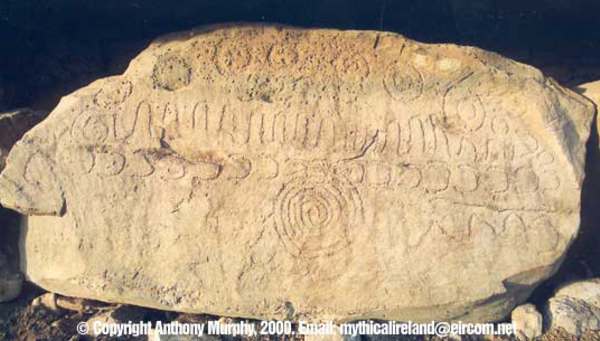
This kerbstone at
Knowth proves that the people of the Neolithic were
competent astronomers, who had made observations over
great periods of time, and were able to pass on their
astronomical knowledge from generation to generation. The
Lunar Stone presents a format that can be used to track
the synodic month, and from it we can obtain very
important calculations of large subunits of the Lunar, or
"Metonic",
Cycle.
What this stone demonstrates is that the Neolithic people who constructed the mound were aware that the solar year, which is 365 days long, does not contain an equal number of synodic periods of the Moon. But it also shows they were aware of the great 19-year Lunar Cycle and studied the movements of the moon over long periods of time.
A synodic period of
the Moon is marked by the return of the Moon to the same
phase, and is exactly 29.531 days long. So therefore, 12
lunar months, or 'Synodic months' is exactly 354.372 days
long. But this is a whole 11 days shorter than a tropical
year. The Neolithic mound-builders knew this, and used
the Lunar Stone to record their calculations of the
numbers of synodic lunar months in tropical years.
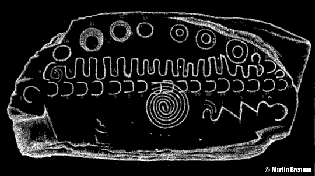
25 synodic months is 738.275 days, which is 8 days longer
than 2 tropical yrs.
37 synodic months is 1092.647 days, 3 days short of 3
tropical years.
49 synodic months is 14 days shorter than 4 tropical
years.
62 synodic months is 5 days longer than 5 tropical years.
It is this value in the sequence which is represented on the lunar stone at Knowth. There are a total of 31 'waves' across the stone, surrounded by representations of the Moon – 29 of them – representing the 29 days of the synodic lunar month.
Kerbstone drawn by Martin Brennan who made the original calculations for the meaning of these marks.
When
considering these engravings we must remember that the
method of observation does not require complex equipment
or machinery, and does not involve complicated
mathematics. What it involves is simple observation over
long periods of time. These engravings were obviously an
attempt by the Neolithic astronomers to pass on their
knowledge to the next generation – a quest in which
they succeeded. 5,000 years on we too can get an insight
into the astronomical observations of our "primitive"
ancestors, and we too can watch the heavens and observe
the Metonic cycle for ourselves.
A Letter Written in April 2008 Sunday Tribune.
Mysterious disappearance of Hill of Tara monument
- will cause "world of trouble"
By - Jamie Deasy.
GARDAÍ in Co. Meath are investigating the mysterious
disappearance of a commemorative monument situated on the
Hill of Tara, dedicated to those killed in a battle with
the British army during the ill-fated 1798 rebellion. The
memorial stone was built into a wall on the roadside on
the border between the townlands of Odder and Castleboy
on the Hill of Tara.
The inscription on the granite memorial stone read:
"1798-1998 In memory of the Croppies who gave their
lives for Ireland, 26th. May 1798 Erin Go Bragh".
The five-feet by three-feet granite monument, erected in
1998 by a group called Comoradh Rioch na Mhi, also
depicted a pike, which was the weapon most commonly used
by the ill-equipped patriots.
Speaking to the Sunday Tribune, Patrick Pryle, one of the
founding members of Comoradh Rioch na Mhi and a resident
of Skyrne, said whoever removed the memorial had wiped
out all traces of its existence.
"Someone has pulled out the bank where the memorial
was located, it has been re-landscaped and grass seed has
been sown on it", he said.
"There is going to be a world of trouble about this.
I have got calls from pike groups in Wexford who are
going to organise buses to come up here and protest.
These people consider Tara to be sacred. They set up
groups to commemorate the rebellion in Wexford".
He added that he has written to the Office of Public
Works, the Meath county manager and the chief
superintendent of the gardaí in Navan asking them to
investigate the matter.
"The attack on this monument is a direct attack on
the state, its laws, its institutions and our own very
freedom. The men, women and children who lie in those
unmarked graves have earned our respect and they should
be allowed to lie in peace", he continued.
"It is sacred land and it is under the protection of
the state and it is up to the state to protect its own
property and the memory of these people who died for
Ireland".
The Hill of Tara played a central role in the failed
rebellion organized by the United Irishmen.
On 26th. May 1798, in one of the most significant
incidents of the revolt, some 5,000 natives of counties
Meath, Dublin, Wicklow, Kildare and Westmeath assembled
on the Hill of Tara to support the insurrection.
However, like in most other parts of the country, the
crown forces defeated the rebels and it is estimated up
to 400 of them were killed on the Hill of Tara where they
still lay buried to this day in unmarked graves.
The 1798 rebellion was probably the bloodiest outbreak of
violence in Irish history and resulted in an estimated 15,000
- 30,000 deaths over a three-month period.
A spokesperson for the Office of Public Works said they
were investigating the matter and were attempting to
establish whether the memorial was located on public land.
Sergeant Tom Flynn at Navan garda station also confirmed
the gardai are investigating the case.
He urged anyone with information to contact Navan gardaí
at
© The Sunday Tribune, 27th. April 2008.
www.savetara.com;www.tarapixie.net;www.taratemple.net;
www.sacredIreland.org;www.tarasolidarityvigil.net
; http://homepage.eircom.net/~guerin/videos.html
www.schnews.org.uk;
http://www.livevideo.com/video/1078F7A1974C4180AC7C538E44A46D27/
www.tara-tara-tara.aspx
; www.savetaravalley.com
; www.taranetwork.org
